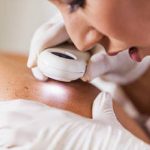
Learn how to screen yourself for skin cancer.
According to the Skin Cancer Foundation, more people are diagnosed with skin cancer than all other forms of cancer combined. Around one in five people will develop a form of skin cancer by the time they are 70. Checking your skin regularly for any new or changing spots is critical to preventing and treating precancerous and cancerous spots early. The following are steps you can follow to conduct regular, thorough skin checks on yourself.
Skin Cancer Symptoms
There are three types of skin cancer: basal cell carcinoma, squamous cell carcinoma, and melanoma, with melanoma being the most serious type. Performing regular skin checks can help you catch any unusual changes in your skin early and have them checked out by a dermatologist.
When checking your skin, follow the ABCDEs of skin cancer:
– A: Asymmetry or where one half of the mole is different from the other half;
– B: Border or where it has an irregular or ragged border;
– C: Color or a mole with varied colors like tan, brown, blue, red, or white;
– D: Diameter or has a size larger than a pencil eraser;
– E: Evolving, where the mole is different from the rest of your moles or is changing in shape, color, and size.
If you do notice any moles or lesions that are different from the others, or that are changing, itching, or bleeding, call our office to make an appointment with one of our board-certified dermatologists. The earlier a skin cancer is caught, the more treatable it may be.
Assemble The Right Materials
When performing a skin check, make sure you have a full-length mirror, a hand-held mirror to check the skin on your back, and a bright light to see your skin clearly. Be sure to note any unusual areas you find so you may discuss them with your dermatologist.
Know How To Check
The American Academy of Dermatology recommends the following steps to conducting a skin check:
- Examine your body front and back in the mirror, then look at the right and left sides with your arms raised.
- Bend elbows and look carefully at forearms, underarms, and palms.
- Look at the backs of your legs and feet, the spaces between your toes, and the soles of your feet.
- Examine the back of your neck and scalp with a hand mirror. Part hair for a closer look.
- Finally, check your back and buttocks with a hand mirror.
If you do find any area of concern on your skin, call our office to schedule an appointment to have it seen by one of our board-certified dermatologists.
For more information on how to conduct a skin check as well as to learn more about skin cancer, visit https://www.aad.org/public/spot-skin-cancer/learn-about-skin-cancer/types-of-skin-cancer.
SCS CAN MEET ALL OF YOUR GENERAL AND COSMETIC DERMATOLOGY NEEDS
Skin Care Specialty Physicians has been serving the residents of the greater Baltimore area for over ten years. From skin cancer screenings to treatments for hair loss, eczema, acne, and more, we treat conditions affecting your skin, hair, and nails. We diagnose a wide range of skin conditions each day and work with you to select treatment options that best fit you and your skin. We also offer variety of cosmetic treatments and procedures, ranging from botox to microneedling, to fit you and your aesthetic goals. If you are interested in any of our services, contact us at 410.252.9090. You can also follow SCS Physicians on Facebook, Twitter, Google+, Linkedin and Pinterest.
